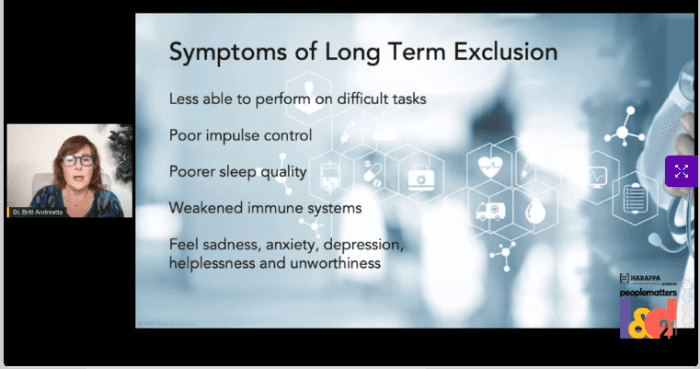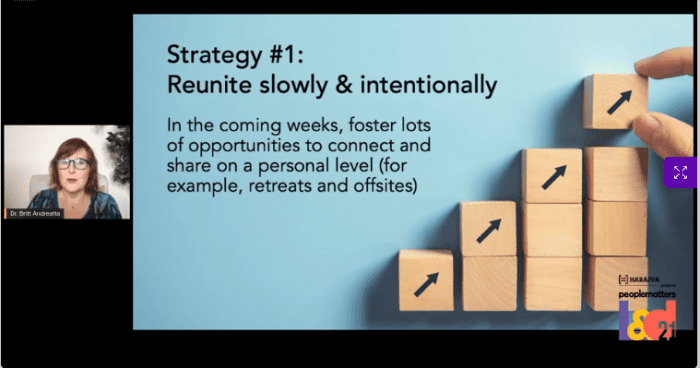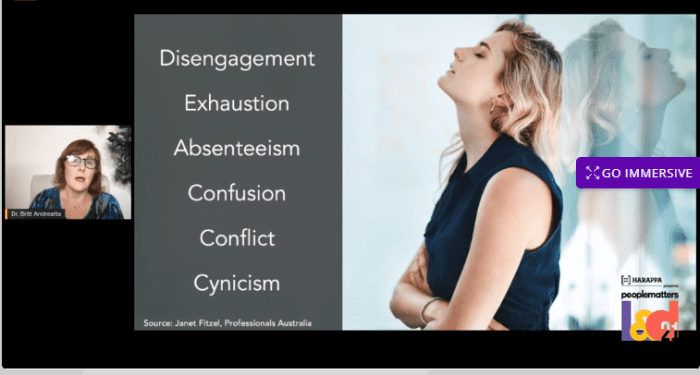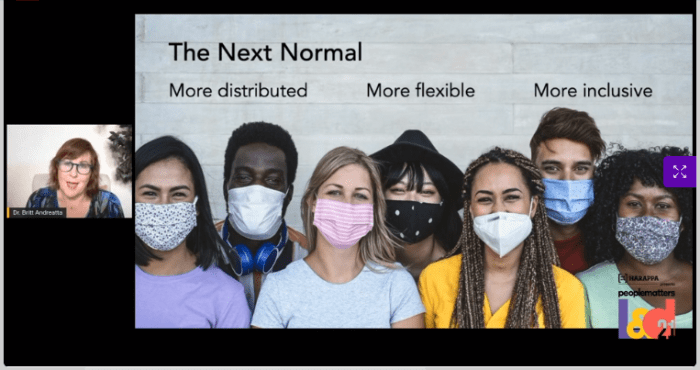Reuniting: The science of rebuilding connection and trust

As the world opens up and we come back together, we'll need to navigate new territory in our work relationships. While we have been sustaining our team connections and productivity while working from home, we have been slowly creating new norms and styles of engagement.
What does neuroscience tell us about what helps teams thrive and why we need to be particularly mindful as we emerge from isolation? In her keynote session at People Matters L&D SEA 2021, Britt Andreatta, Author and Former CLO, Lynda.com shared three strategies one can implement right away as we build back better. These three key areas to focus on are survival and belonging, burnout and attrition, and habits in the new normal.
Survival and belonging
As humans, we are wired to survive, to belong, and to become. The pandemic this year showed how much our need to survive can get threatened as an invisible virus made us vulnerable. Safe places now need to be cleaned down. These threats are worrying us and causing us to stress constantly.
Secondly, we are a tribal species, which is wired to belong and be accepted as we are. To belong is to matter. A big part of our belonging comes from our jobs and being at work, being a part of our community, and from our families. The pandemic made it difficult to meet people we love and we have to be distant from others. Our sense of belonging has got shifted with the pandemic making us view people as dangerous and fret how they can harm me. So our relationships- as to how we see other humans- have been impacted.
Similarly, working virtually with people for a year has exhausted us. Our bodies have to work harder as it’s not the same as working in person together. So people are feeling isolated which has impacted their sleep, affected social anxiety, and their mental health.

As a result, people are less able to perform on difficult tasks, have poor impulse control, and poorer sleep quality, and weakened immune systems. This is why we see the rise of mental health issues as not all people while working from home, feel that they belong and are feeling disconnected.
So the first strategy to keep in mind as we come back together is to do it slowly and intentionally. We can do this by fostering opportunities to connect on a personal level for instance retreats and off-sites. We can also do it with online tools for the same. Similarly, start it slowly maybe with half days to make it comfortable for people to rebuild that sense of trust.

Burnout and attrition
The second issue at hand is burnout and attrition as people have been dealing with a pandemic for over a year and they are exhausted. We have hit a level of physical and mental exhaustion that we have not seen before and some of it is due to change fatigue. The symptoms of change fatigue are disengagement, conflict, absenteeism, confusion, and cynicism.
Burnout is a state of emotional, mental, and physical exhaustion brought on by long-term stress and we are all burned out. While we can endure it for a period of time on account of the surge capacity of our body but that amount in our body is normally a six-month window. We are long past that, feeling exhausted and with a decreased sense of accomplishment. This can make people feel that they can’t really anything get done at work, which means some of the people could be a flight risk.

So companies need to pay attention as it could cause a lot of attrition. This takes us to strategy number two which is to really nurture your people now as they need it now more than ever. Companies need to focus on providing services that reduce stress and burnout, like paid time off, wellness programs, and mental health services. It is also a good time to recognize and promote your top talent-anything to show them some love and let them know that you value them.
Habits in the new normal
This virus disrupted all our old patterns and we had to develop new habits to adapt. Habits are hard at first but our brains, especially the basal ganglia, are designed to turn something that’s hard at first into something easy that we don’t have to think about. With 20 repetitions, a neural pathway has formed but on an average of 40-50 repetitions, is when we form a habit and it becomes automatic. At 66 repetitions, the neuron gets thicker, almost building like a muscle.
We developed new habits as we pivoted to working from home, for instance, the habit of working in your pajamas or multitasking in ways that we would not do in a regular face-to-face meeting or not commuting to work or parenting while working. So we have been in this new normal and when we come back together, we will be creating the next new normal. That will also require building new habits, unlearning some of the habits we formed in the pandemic, and relearn new ways as we start reunification of our workplaces.
Pretty soon we will start working closer again and that will take time to get people comfortable with each other. However, the next normal is going to be more distributed, more flexible, and more inclusive.

We are building something much better than we had in the past. As we come back, it’s a great time to make those workplace changes that you wanted to make to build the next normal better. So our next strategy here should be to have a plan for developing the new habits. Companies need to start listening to what people are worried about and design a better workplace and culture, use this time of change and innovation to build back better than ever, and celebrate effort and progress as people come back, which will help them get through the challenge of reuniting.

















